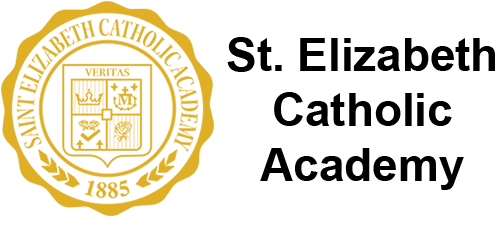Catholic Identity
St. Elizabeth Catholic Academy is primarily a Catholic school. By choosing to enroll in SECA, you understand that all students study Religion and receive a Report Card grade for the class. All students attend mass and prayer services. Our students engage in prayerful activity several times throughout the school day.
We welcome students of all faiths and do our best to foster a climate of appreciation for all the religions practiced by the families of our SECA students. In turn, we expect the proper respect of our academy’s catholic identity to be shown by all students through participation in the required religious exercises noted above.
Parish Participation
Parents are the primary educators of their children. It is imperative that parents instill the importance of faith by way of their active participation in Sunday mass. All students who are Catholic should attend mass weekly.
Our Patroness
St. Elizabeth of Hungary was born in 1207. Betrothed at the age of four to Louis of Thuringia, Elizabeth was raised at the court of her future in-laws. She was a very devout child and was taunted for her faith by Louis’ mother, Sophie, and the ladies of the court.
Finding no refuge in the castle for her sore heart, Elizabeth went abroad among the serfs and peasants, ministering to all who were afflicted in body or soul. Word of this spread throughout the land, and there came to the castle gates many who were maimed, diseased, or blind. Sophie, angered all the more by this, would look down from the castle turret and say, “Look at yonder fools – and she among them!” When Louis succeeded his father in 1221, he and Elizabeth were married. It was a happy marriage. Louis’ love for Elizabeth stood as a shield against the treacheries of the court.
The land was soon stricken with a terrible famine. Even the castle granaries had little wheat left. Members of the court complained to Louis, “Your wife gives and gives to the poor and soon we will have no bread. Curb this madwoman of yours or we will all die.” Fearing more that harm might come to Elizabeth, or that she herself might contract a deadly disease, Louis sternly forbade her to feed the poor or tend the sick. Elizabeth still heard the cries of the hungry and dying. One night, when she could bear it no longer, she left the castle, her arms laden with bread taken from the castle kitchens. Louis came upon her, unawares; and seeing her, his face hardened for the first time with anger. He flung aside her cloak, and where there had been bread, there were now roses. Louis knelt at the sight of this miracle, asking God for His merciful forgiveness.
Louis felt called to go on a Crusade in 1229 and died of the plague three months later. His brother claimed the throne and forced Elizabeth and her children to leave the court. After finding suitable people to take care of her children, she entered a convent and lived in poverty, ministering to the poor. Her charity and generosity were legendary. She died at the age of 24 and was canonized in 1235 by Pope Gregory IX. Her feast day is November 17th.
The miracle of the bread and roses is depicted in a mosaic at the entrance to St. Elizabeth Catholic Academy.
